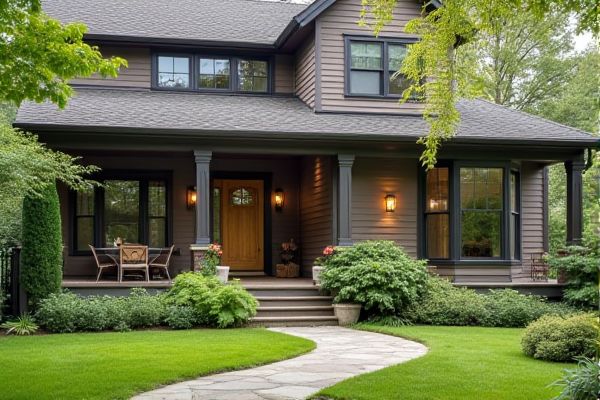
The front porch often serves as a welcoming space that enhances curb appeal and social interaction with neighbors, while the back porch provides a more private area for relaxation and outdoor dining. Explore the rest of this article to discover which porch best fits Your lifestyle and home design needs.
Table of Comparison
| Feature | Front Porch | Back Porch |
|---|---|---|
| Location | At the front entrance of the house | At the rear of the house |
| Purpose | Welcoming guests, curb appeal | Private outdoor space, relaxation |
| Privacy | Less private, visible from street | More private, shielded from public view |
| Size | Typically smaller and decorative | Often larger for seating and activities |
| Furniture | Chairs, small tables, decorative items | Outdoor sofas, dining sets, grills |
| Usage | Greeting visitors, casual sitting | Entertaining, dining, relaxation |
| Exposure | Faces the street, exposure to public | Faces backyard, more sheltered |
Understanding the Roles of Front and Back Porches
Front porches serve as welcoming transitional spaces that enhance curb appeal and foster neighborly interaction, often reflecting a home's architectural style. Back porches function as private retreats for relaxation, outdoor dining, and family gatherings, offering a more secluded environment. Both porches contribute uniquely to a home's usability and aesthetic, balancing social engagement and personal comfort.
Curb Appeal: Front Porch as Your Home’s First Impression
The front porch serves as a key element of your home's curb appeal, creating the very first impression for visitors and passersby with its inviting design and decor. Unlike the back porch, which is typically more private and functional, the front porch enhances your home's exterior curb appeal by showcasing architectural details and landscaping that highlight your property's style. Investing in a well-maintained and aesthetically pleasing front porch significantly increases your home's market value and attracts potential buyers.
Backyard Retreat: Privacy and Relaxation on the Back Porch
The back porch serves as an ideal backyard retreat, offering enhanced privacy and a serene environment for relaxation away from street noise and foot traffic. Surrounded by landscaping or fencing, it creates a secluded space perfect for unwinding, entertaining guests, or enjoying morning coffee. This area often accommodates comfortable seating, outdoor dining, and decorative elements that blend with the natural surroundings for a peaceful ambiance.
Social Spaces: Entertaining Guests on Porches
Front porches create inviting social spaces that foster neighborly interaction and enhance curb appeal, making them ideal for casual gatherings and welcoming guests. Back porches offer more privacy and flexibility, perfect for intimate get-togethers, barbecues, and family entertaining in a secluded setting. Your choice depends on the type of social atmosphere you want to cultivate, balancing visibility with comfort.
Design Differences: Front Porch vs Back Porch Styles
Front porch designs typically emphasize curb appeal with classic, welcoming features like columns, railings, and symmetrical layouts that complement the home's facade. Back porches prioritize functionality and comfort, often incorporating spacious seating areas, outdoor kitchens, or screened enclosures tailored for privacy and relaxation. Understanding these style differences helps you choose the right porch design to enhance both your home's aesthetic and your lifestyle needs.
Functional Uses: Daily Life on Front and Back Porches
Front porches serve as social spaces for greeting neighbors and enjoying street views, enhancing community interaction. Back porches offer more privacy and versatility, ideal for family gatherings, outdoor dining, and personal relaxation. Your choice depends on whether you prioritize social engagement or secluded comfort in daily porch use.
Outdoor Living: Enhancing Comfort and Utility
Front porches create inviting outdoor living spaces that enhance curb appeal and foster neighborly interactions, offering comfort with seating and shade. Back porches prioritize privacy and versatility, often equipped for dining, cooking, and relaxation, optimizing utility for family gatherings or quiet retreats. Both porch types increase functional outdoor living areas, boosting home value and lifestyle satisfaction.
Security and Safety Considerations
A front porch typically offers better security due to its visibility from the street and closer proximity to neighbors, making it easier to monitor and deter potential intruders. In contrast, a back porch may feel more private but often lacks natural surveillance, increasing the risk of unnoticed break-ins or accidents in poorly lit areas. Enhancing your porch's safety involves installing adequate lighting, security cameras, and sturdy locks regardless of its location.
Property Value Impact: Which Porch Adds More?
A front porch generally adds more property value due to its curb appeal and role in enhancing the home's exterior aesthetics. It creates an inviting entryway that attracts potential buyers and increases marketability. While a back porch offers private outdoor living space, it typically has less impact on overall resale value compared to a well-designed front porch.
Choosing the Best Porch for Your Home
Selecting the best porch for your home depends on your lifestyle and intended use; a front porch offers curb appeal and social interaction with neighbors, while a back porch provides privacy and a relaxing retreat. Consider factors like sun exposure, space for furniture, and ease of access when deciding between the two. Your choice should enhance both the functionality and aesthetic value of your property.
 homyna.com
homyna.com